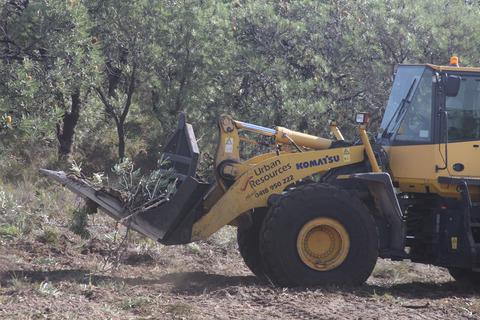当前位置:
X-MOL 学术
›
Appl. Veg. Sci.
›
论文详情
Our official English website, www.x-mol.net, welcomes your feedback! (Note: you will need to create a separate account there.)
Best served deep: the seedbank from salvaged topsoil underscores the role of the dispersal filter in restoration practice
Applied Vegetation Science ( IF 2.8 ) Pub Date : 2020-11-15 , DOI: 10.1111/avsc.12539 Paweł Waryszak 1 , Rachel J. Standish 2 , Philip G. Ladd 2 , Neal J. Enright 2 , Mark Brundrett 3 , Joseph B. Fontaine 2
Applied Vegetation Science ( IF 2.8 ) Pub Date : 2020-11-15 , DOI: 10.1111/avsc.12539 Paweł Waryszak 1 , Rachel J. Standish 2 , Philip G. Ladd 2 , Neal J. Enright 2 , Mark Brundrett 3 , Joseph B. Fontaine 2
Affiliation

|
Questions Globally, ecological restoration is required to restore degraded landscapes and to contribute to biodiversity conservation. Ecological theory suggests that manipulating dispersal, abiotic and biotic filters limiting plant re‐establishment will improve restoration outcomes. Here, we manipulated spread depth of soil containing a salvaged soil seedbank (dispersal filter), soil compaction (abiotic filter) and herbivore grazing (biotic filter) in a topsoil transfer experiment to test their effects on restoration success. Location Banksia woodland of the Swan Coastal Plain, Western Australia. Methods Topsoil (upper ~7 cm) with its seedbank was removed from a donor site (20 ha) of recently cleared native vegetation and transferred to six recipient restoration sites (16 ha). Deep (10 cm thick) and shallow (5 cm thick) layers of topsoil were applied in a fully factorial experiment, with and without soil ripping and fencing, respectively. We analysed emergence, survival and functional types (alien/native, life form, fire response) of all vascular plant species for two consecutive years after topsoil transfer. Results The most successful restoration treatment was deep topsoil with a mean density of 14.3 m−2 native perennial germinants in year one and 7.3 m−2 in year two. Application of deep topsoil increased native seedling emergence by 34% and decreased weed density by 21% compared with shallow topsoil. Overall seedling survival across the two‐year period was unaffected by filter treatments (range 0.6%–5%). After two years, the resulting plant community was 6%–38% weed species and of native perennial species, 12%–48% were capable of resprouting. Conclusions Manipulation of the dispersal filter alone, that is deep topsoil application, can lead to near‐equivalent native species number emerging on restoration sites as compared to pre‐cleared woodland. However, more research is required to test additional restoration tools to improve survival of biodiverse plant communities. For example, targeted herbicide application coupled with soil ripping to improve weed management and native seedling establishment.
中文翻译:

最好的深度服务:来自回收表土的种子库强调了分散过滤器在恢复实践中的作用
问题 在全球范围内,生态恢复需要恢复退化的景观并为生物多样性保护做出贡献。生态理论表明,操纵限制植物重建的分散、非生物和生物过滤器将改善恢复结果。在这里,我们在表土转移实验中操纵了包含回收土壤种子库(分散过滤器)、土壤压实(非生物过滤器)和食草动物放牧(生物过滤器)的土壤的扩散深度,以测试它们对恢复成功的影响。位置 西澳大利亚天鹅海岸平原的班克西亚林地。方法 将表土(上部~7 厘米)及其种子库从最近清除的原生植被的捐赠地点(20 公顷)移走,并转移到六个接受者恢复地点(16 公顷)。在全析因试验中分别施用深(10 厘米厚)和浅(5 厘米厚)表土层,分别有和没有土壤撕裂和围栏。我们在表土转移后连续两年分析了所有维管植物物种的出现、存活和功能类型(外来/本地、生命形式、火灾响应)。结果 最成功的恢复处理是深层表土,第一年平均密度为 14.3 m-2 本地多年生发芽植物,第二年为 7.3 m-2。与浅表土相比,深表土的施用使本地幼苗出苗率提高了 34%,杂草密度降低了 21%。两年期间的整体幼苗存活率不受过滤器处理的影响(范围 0.6%–5%)。两年后,由此产生的植物群落为 6%–38% 的杂草物种和本地多年生物种,12%–48% 能够重新发芽。结论 与预先清除的林地相比,单独操纵分散过滤器,即深层表土施用,可导致恢复地点出现近等量的本地物种数量。然而,需要更多的研究来测试额外的恢复工具,以提高生物多样性植物群落的存活率。例如,有针对性地施用除草剂与土壤撕裂相结合,以改善杂草管理和本地幼苗的建立。
更新日期:2020-11-15
中文翻译:

最好的深度服务:来自回收表土的种子库强调了分散过滤器在恢复实践中的作用
问题 在全球范围内,生态恢复需要恢复退化的景观并为生物多样性保护做出贡献。生态理论表明,操纵限制植物重建的分散、非生物和生物过滤器将改善恢复结果。在这里,我们在表土转移实验中操纵了包含回收土壤种子库(分散过滤器)、土壤压实(非生物过滤器)和食草动物放牧(生物过滤器)的土壤的扩散深度,以测试它们对恢复成功的影响。位置 西澳大利亚天鹅海岸平原的班克西亚林地。方法 将表土(上部~7 厘米)及其种子库从最近清除的原生植被的捐赠地点(20 公顷)移走,并转移到六个接受者恢复地点(16 公顷)。在全析因试验中分别施用深(10 厘米厚)和浅(5 厘米厚)表土层,分别有和没有土壤撕裂和围栏。我们在表土转移后连续两年分析了所有维管植物物种的出现、存活和功能类型(外来/本地、生命形式、火灾响应)。结果 最成功的恢复处理是深层表土,第一年平均密度为 14.3 m-2 本地多年生发芽植物,第二年为 7.3 m-2。与浅表土相比,深表土的施用使本地幼苗出苗率提高了 34%,杂草密度降低了 21%。两年期间的整体幼苗存活率不受过滤器处理的影响(范围 0.6%–5%)。两年后,由此产生的植物群落为 6%–38% 的杂草物种和本地多年生物种,12%–48% 能够重新发芽。结论 与预先清除的林地相比,单独操纵分散过滤器,即深层表土施用,可导致恢复地点出现近等量的本地物种数量。然而,需要更多的研究来测试额外的恢复工具,以提高生物多样性植物群落的存活率。例如,有针对性地施用除草剂与土壤撕裂相结合,以改善杂草管理和本地幼苗的建立。


























 京公网安备 11010802027423号
京公网安备 11010802027423号